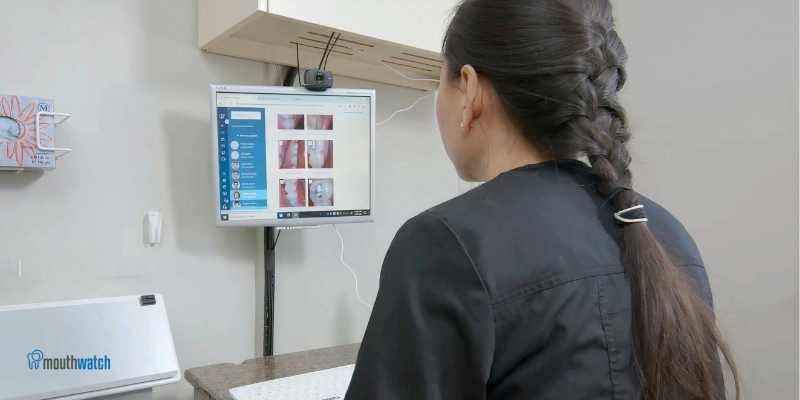
Intraoral cameras and teledentistry are sometimes viewed as independent from one another. Many providers initially understand teledentistry as a tool solely for remote communication and collaboration with patients, specialists, and other providers. While teledentistry is great for communicating and collaborating remotely across patients’ dental journeys, it can also be an effective in-office workflow. Similarly, intraoral cameras don’t have to be used just for one-on-one patient communication and education.
In fact, we designed our teledentistry platform, TeleDent, to natively integrate with MouthWatch intraoral cameras. Together, they can create a more comprehensive, connected-care experience for patients and providers alike. But how can you actually use intraoral cameras and teledentistry together?
Asynchronous Communications
Teledentistry doesn’t always have to mean a live synchronous encounter. One of the most popular ways dental professionals use intraoral cameras and teledentistry together is with store and forward teledentistry. Dental professionals can store the detailed intraoral photos they take during an in-person meeting and safely and securely share those photos, along with radiographs and other clinical data, with dental or medical providers who can remotely evaluate that data.
This method enables providers to be more efficient with the time they have with their patients. Dentists can quickly retrieve patient information from past visits or visits with other dental or healthcare professionals, allowing you to be better informed and better treat patients in a timely manner that’s convenient for both you and your patient.
These intraoral images you capture during an appointment, along with notes and procedures, can also be used to create detailed visual treatment plans that providers can share with patients to help them understand the current state of their oral health and why treatment is recommended.
Patients can access compelling visual treatment plans and securely communicate with their provider using TeleDent’s chat messaging. Patients can bring up concerns or ask any questions they may have about treatment plans or their oral health whenever and wherever they are.
As a result, dental professionals can streamline treatment planning, efficiently connect with their referral network, increase patient touch points, and create better access to dentistry for more patients, ultimately leading to better patient outcomes.
In-office Teledentistry
Synchronous consultations, and evaluations with remote professionals and specialists, can also be done while a patient is in the office. With multi-party video call capabilities on platforms like TeleDent, dentists can stream video from their intraoral camera and webcam feed to a remote specialist and other professionals involved in the patient journey in the same call. This allows everyone involved in the patient journey to ask questions, see detailed views of the patient’s mouth, and get the information needed all within one video call. These calls also make establishing a trusting relationship with a remote specialist easy.
Traditional referrals that rely on patients acting on the business card they’re handed at the end of an appointment frequently don’t convert into a specialist appointment. When patients can meet the specialist virtually, ask questions, and get educated on the condition of their oral health, patients are more likely to schedule a specialist appointment and accept treatment recommendations to get the care they need. This one interaction assists in reducing uncertainty and dropped treatment opportunities, ultimately improving health outcomes for your patients.
New Opportunities
The repetitive, clinical nature of dentistry can lead to your team members feeling burned out and wanting more out of their careers in dentistry. Combining teledentistry and intraoral cameras can offer your team new opportunities to connect with new patients through mobile hygiene programs, pop-up clinics, and on-site dental visits. Team members can perform offsite preventive care and screenings without the dentist needing to leave the office.
Hygienists are able to capture dental imagery with intraoral cameras and send those photos along with other clinical paperwork to the remote dentist, where they can decide if the patient needs additional care. Synchronous consultations with a remote dentist are also useful for cases where a live video feed would help dentists better understand a patient’s condition to formulate the best possible treatment plan.
These opportunities enable your team to get out of the office, increase patient touch points, generate referrals, and, most importantly, create new and exciting opportunities that promote professional growth and keep team members engaged.
Intraoral cameras and teledentistry go hand-in-hand. With MouthWatch intraoral cameras natively integrating with TeleDent, it’s as easy as plugging your camera into a TeleDent-enabled tablet or computer to start benefiting from this initially unlikely but effective duo.
